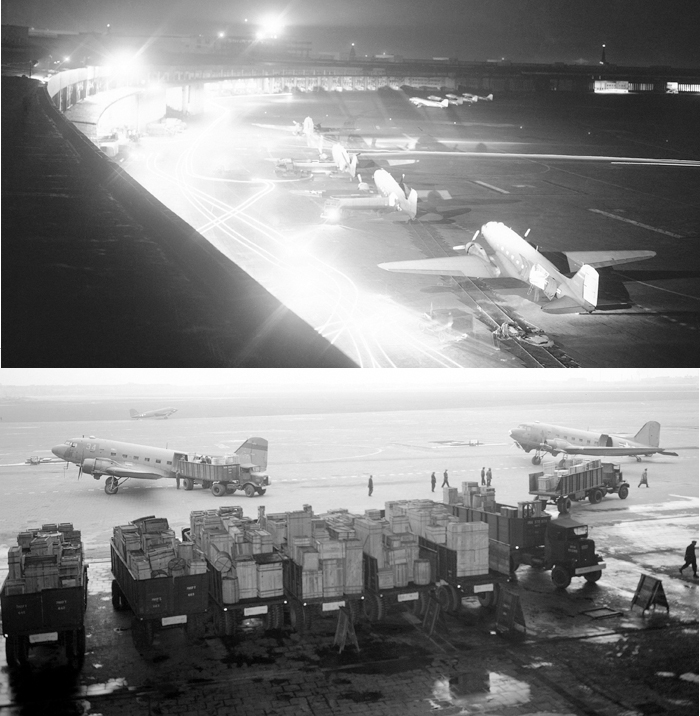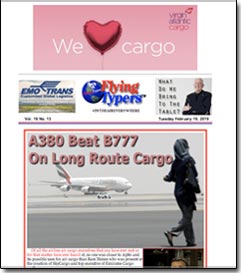|
Now for
everybody who loves aviation, and especially folks that today live and
work in air cargo, comes a unique opportunity. Right on
the heels of a major world gathering—Air Cargo Europe in Munich,
Germany at Transport Logistik June 4-7, the 70th anniversary of the Berlin
Airlift is being celebrated in grand style from June 10 until June 18.
Eight days full of events featuring the people and more than 40 aircraft
gathered from all over the world, returning to Germany, where modern air
cargo made history saving the city of Berlin in 1948-49.
The "heroes" of this hitherto
unique humanitarian aid action and solidarity were the aviation and ground
crews of the "Raisin Bombers”.
 |
That name was given to aircraft that had
once appeared above the City of Berlin spelling destruction, but in a
complete reversal just three years after the end of World War II, returned,
delivering coal and food. The air cargo crews often gave the children,
who gathered at the airport to watch the action taking place, Hershey
bars and other candy and fruit, thus the name, Raisin Bombers.
In June 2019, the historic "Raisin
Bombers" will return for the 70th anniversary of the Airlift - most
likely for the last time.
The machines of the era will all be there
including DC3 / C 47, DC4 and JU 52, making their way to Berlin and elsewhere
in the original path of the 48-49 Airlift.
Nearly 40 aircraft are coming, or enough
to recreate the Airlift at the original time intervals, accompanied by
multi-day public events and school and youth projects.
For the first time in history, the Airlift
will be visible and tangible for today's generation.
At the airports in Wiesbaden-Erbenheim,
at Faßberg (Lower Saxony, 10 km from Munster), at Schleswig Jagel,
at Schönhagen (40 km south of Berlin), crews and machines will be
at the disposal of the public.
Berlin Airlift 2019 will be an "air
bridge to touch".
For More: click here.
 |
Why Berlin Airlift Matters in 2019
Apart from the blockade of street traffic
in 1948 the Soviets also successively blocked all routes by land, rail,
and water between West Berlin and the three Western zones.
Only the air corridors on which the four
victorious powers had agreed in the Air Agreement of 1945/46 were unaffected.
As Berlin began to starve, the three Western powers commenced an Airlift
to supply the city and its approximately two million inhabitants with
the necessities of life.
It was an ambitious plan never before attempted
on this scale and it was unclear whether it would work.
On July 28, 1948, the first American and
British aircraft landed at Tempelhof and Gatow airfields with goods for
the people of Berlin.
Many other flights followed, but nobody
could predict how long the blockade would last.
For that reason, the Western powers initially
planned to supply the city into the winter.
The aim during the first weeks of the Airlift
was to fly 4,500 tons of goods into the city every day.
This was raised to 5,000 tons a day in the
autumn of 1948.
Coal to meet the city’s energy needs
made up a large proportion of the tonnage.
In October U.S. General William H. Tunner
was appointed to head the Combined Airlift Taskforce (CALTF), which had
its headquarters in Wiesbaden. He perfected the Airlift.
The American military governor of Germany,
General Lucius D. Clay, ensured the necessary political support of U.S.
President Harry S. Truman.
Clay continually requested more and larger
aircraft to use in the Airlift, and Truman approved them.
In the first months of the Airlift, the
French occupying power participated with six airplanes.
The urgently needed third Berlin airport
called Tegel in the French sector was completed in November 1948.
Some 19,000 workers built it in record time,
taking just three months.
The British mobilized the Royal Air Force
and contracted with an additional 25 charter companies to fly mainly oil
and gasoline into Berlin.
Aside from moving a healthy 23% volume of
the total Airlift tonnage during the Airlift, the British were also responsible
for the lion’s share of passenger transport during the blockade.
With their C-54-transport planes, the U.S.
forces provided the largest air fleet for “Operation Vittles,”
as the Americans called the mission.
 In the Spring of 1949, the operation to
supply Berlin was working so well that on some days more goods were flown
into the city than had arrived before the blockade by road, water, and
rail combined. In the Spring of 1949, the operation to
supply Berlin was working so well that on some days more goods were flown
into the city than had arrived before the blockade by road, water, and
rail combined.
The Western powers used the media very effectively
to publicize this outstanding efficiency.
Included in this coverage was FlyingTypers’
own senior contributing editor, the late Richard Malkin, (pictured
at the Reichstag).
The continued positive reporting on Allied
tonnage and the growing reputation of the Western powers were certainly
part of the reason for the lifting of the Soviet blockade on May 12, 1949.
Despite the end of the blockade, the Airlift continued for another four
months into late summer 1949.
The historical events known as the “Berlin
Blockade” and the “Berlin Airlift” are thus chronologically
not wholly identical.
The lifting of the blockade and the end
of the Airlift solved the first crisis of the Cold War by logistical means
– without military force.
This does not, however, mean that there
were no casualties of the Airlift.
At least 78 people died in airplane accidents.
Their names are engraved on the base of
the Airlift Memorial in the Berlin district of Tempelhof.
Occupiers Become Protectors
The Berlin Airlift palpably changed the
relationship between the Western powers and West Berlin.
Just a few years after World War II, the
one-time enemies had mastered a severe political crisis by intensive cooperation.
The population of Berlin now experienced the occupying powers as protecting
powers.
The world in general was also made aware
of the growing potential of air cargo.
Geoffrey
|




 Vol. 18 No. 13
Vol. 18 No. 13 